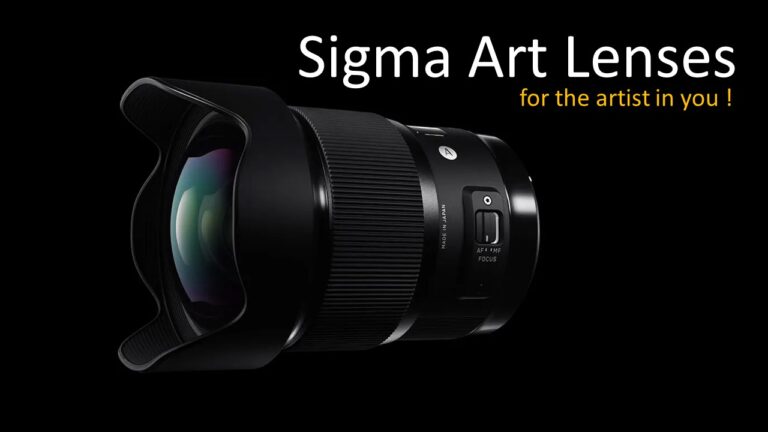A disposable camera is also known as a single-use camera. It’s intended to be used only for one roll of film. This type of camera is similar to other film-based cameras in that it has a shutter and a lens. However, the disposable housing is discarded after the film is processed. The interface of disposable cameras is simpler than reusable cameras and has fewer features.
In this article we will see what is a disposable camera and how a disposable camera works ?
What Is A Disposable Camera ?
These small, disposable cameras come in small boxes and have preloaded film. In some cases, they even have a flash. These cameras are sturdy and reliable, so they can be used for amateur-grade photography.
Disposable means the camera can be used in one setting, then discarded. Not all disposable cameras go to the trash. However, those with preloaded film can be mailed off for development.
Disposable cameras are completely different than the modern day DSLR or mirrorless cameras.
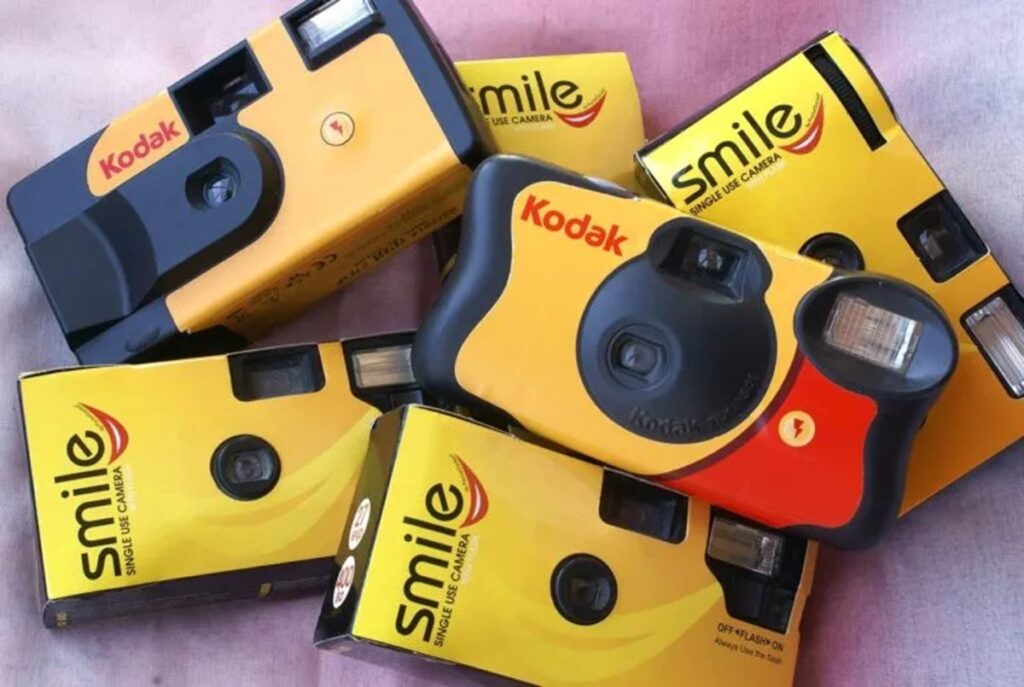
Sometimes, these cameras can be refilled and resold again. Most often , the cameras are discarded once the film is removed.
Consumers who don’t want a preloaded film in the camera may refill them by themselves and use them again and again.
The first disposable camera was capable of only eight exposures. Today’s film cameras can take between 24 and 27 exposures. These cameras are ideal for taking on the go photographs.
Vacations , road trips , small events , kids parties and anywhere you need to grab something quickly.
A digital disposable camera can store approximately twenty-five photographs. Add a memory card and it can hold thirty more.
Why disposable cameras are making a comeback ?
After seeing digital’s clarity and ease of use, why would you want to go back to analog film? There are many reasons disposable film cameras are being returned.
- You get exactly what you shoot, there is no preview or delete option
- You can only take a limited number of exposures so you have to be careful about what you choose to shoot
- The fun of taking your photos is enhanced by the element of surprise
- Printed photos can be shared in ways digital images cannot.
- Analog film captures the moment as it is without any editing or re-do’s
- These cameras are not intrusive and can help to take candid photos
Sometimes, the best way to capture memories is the oldest. This holds true for disposable cameras. People are returning to the disposable camera of old to preserve their memories. This bright, grainy picture brings back childhood memories. Because we have fewer shots, the scenes that we choose to capture are more meaningful.
A disposable camera captures the moment in its rawness. We don’t have any editing options, so we can’t add filters or red eye fixes. We cannot retake the photo if somebody’s hair isn’t straight or someone closed their eyes as the shutter clicked. It is simply what it is.
After two decades of taking ill-conceived photos and presenting them to the world, the vulnerability of these moments is what drew us back to the disposable film camera. We finally come back to being ourselves and enjoying each moment.
How Do Disposable Cameras Work ?
A single-use disposable camera comes with a roll loaded of film. Each time a photo is taken, the user advances the film manually by winding a gear at its top. The user must look through a viewfinder before taking a picture.
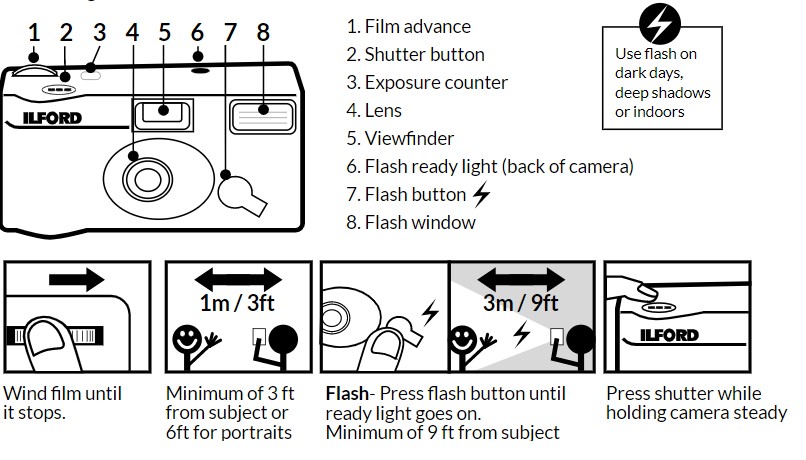
To capture the image on the film, the shutter opens and light enters through the lens. Most disposable cameras do not have an auto-wind function. The film must be advanced and wound before another shot can be taken.
A flash is available for some disposable cameras. A disposable camera’s flash can’t be used to detect whether it is needed, unlike advanced cameras. Instead, the flash must be manually turned on before you can take a photo. It flashes regardless of the available light.
Here are some great videos that explains how disposable cameras work ?
How to use disposable cameras ?
For the actual shooting of the photo, wind your roller until it stops. To charge the light, press the flash button. To position the camera, use the viewfinder. Hit the top button to take the picture. It is easy and simple to use.
Even with the limitations, disposable cameras can still produce amazing images. Photographers must pay attention to detail and set up in order to make every shot count. Digital formats don’t allow for editing or deletion after the photo has been taken.
Although exposure control is not very good, it is possible to adjust the lighting. For portrait-style photography, use the flash in low-light conditions. Natural light is the best way to capture great photos. To illuminate your subject, position the sun behind you or aim directly at the sun to create shadows. A photo is only as good or bad as the light it receives.
While disposable cameras can be stable, blurring will be prevented by using a surface to shoot on. To stabilize your hands while you are shooting, place the camera on a stable surface such as a bench, tree trunk or post. This is particularly important when shooting in low light. To achieve the desired result, you can use filters on other cameras or through the lenses of polarized sunglasses.
Processing your Disposable Cameras Photos
Many people don’t have the space or equipment to process disposable camera film in their home. Digital disposable cameras also lack an easy plug-and-play option, unlike their reusable counterparts. This means that most people will have to hire someone to take your photos.
Some big retailers, such as Walmart and disposable camera Walgreens, offer in-house processing and even same-day pick-up. However, it is not unusual to drop off your used camera and pick up the next day.
You can also mail disposable cameras to a specialized film processing center if a local processing center is unavailable. Many film processing centers are still available and can process your photos via the mail. The shipping method chosen will determine the turnaround time. However, disposable cameras cannot be trusted for quick turnarounds in this digital age of instant results.
Types of Disposable Cameras
The majority of disposable models have a similar layout and feature set. Cameras have a wind button that allows you to set up a picture and a flash button that needs to be pressed to charge the camera before you can take the shot. You will also have a small viewfinder as well as a basic camera body. Disposables do not have advanced settings or zoom.
While most cameras look the same, not all cameras are created equal. The waterproof disposable camera models come in a plastic housing, which allows for underwater photography and shooting in wet or rainy conditions. While most disposable cameras can be used in natural light, the flash can work well in low-light settings. There are slight differences in flash power and ISO settings between models. The best disposables have the most powerful flash to shoot in low light conditions.
Disposable cameras are only made by a handful of companies. They can be easily purchased online through large retailers like Walmart or online. Instant print cameras and small photo printers that can connect to smartphones have eliminated the need to process film off-site.
Do disposable cameras need batteries ?
Only disposable film cameras that have flashes need batteries. Because it is mechanical, the rest of the camera does not require a power source. The shutter , advancement of role and most other stuff is mechanical and works manually.
The usual power source for flash cameras is a regular AA battery.
How do Fujifilm disposable cameras work ( Kodak cameras also work almost same)
Step 1 : Scroll to the right to advance the film in your camera.
Before you take a photograph, advance the film in the camera to an empty frame. You can do this by placing your thumb on the horizontal scroll wheel embedded in the camera near the viewfinder. Turn the wheel to your right using your thumb. Scroll the wheel to the right until it stops turning.
- Fujifilm waterproof cameras have a scroll wheel that is bright green. It can be found on the top of the camera.
- If you don’t move the scroll wheel to the right before taking a picture, your camera will not take one.
- The thumb wheel is sometimes referred to the scroll wheel.
Step 2 : Slide the button at the top of the camera to turn on the flash.
Turn the flash on if it is dark outside and you feel you will need another light source. Look at the front of your camera to locate the button with four grooves next to the lens. To charge the flash, slide it up. As the flash charges, you will hear a loud sound. This sound will disappear in a matter of seconds. The flash will be ready once the sound has stopped.
- This can be done before or after turning the scroll wheel – it doesn’t really matter.
- If you are shooting in low light conditions, and trying to capture something between 8 and 36 feet (22.4-11.0m) in front you, only turn on the flash.
- You can ignore the flash button and keep it in the off position if you don’t need to. Some Fujifilm disposable cameras don’t have a built-in flash.
Step 3 : Lift the camera to your eye, and then look through the viewfinder
The transparent rectangle at the back of your camera is the viewfinder. It allows you to see through it. To frame your photograph, hold the viewfinder in front of your dominant eye. You can adjust the camera to alter the composition of the subject, so that people, landscapes, or still lives are presented in an interesting manner.
- Pay attention to where the light is coming from. You want the light to reach your subject at an angle. Do not shoot directly into or away form light sources.
- The rule of thirds in photography is a great general rule to use when framing your subject. This rule can be used to adjust the camera’s location so that your subject is in the third of the composition.
Step 4 : To take a picture, press the shutter button at the top of the camera
As steady as possible, hold the camera. Press the button at the top of your camera to take your picture. When you hear the shutter close and open, your photo is taken. To finish your photo, release the button.
- The waterproof models have a lever instead of a button at the top. Pull the lever all the way down until the button clicks. Then, release the lever.
Step 5 : Keep using your camera until the film runs out.
Each disposable Fujifilm camera has 27 exposures. You can see the number of photos left on your Fujifilm disposable camera by looking at the top, next to the button that you use to take photos. Below the transparent plastic is a number. This number shows how many photos are left.
- Before you take each photo, don’t forget the scroll wheel.
- You can’t take anymore photos once your film is gone.
- Fujifilm cameras may not have indicators to indicate how many photos are left.
Best Disposable Cameras
There are many disposable cameras available. They have been around for decades. Not all disposable cameras are created equal. Here’s a list of the 5 top disposable cameras right now.
1. Kodak Funsaver
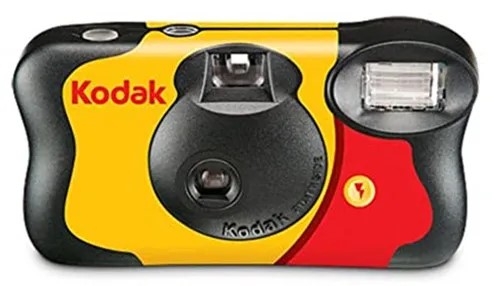
The Kodak FunSaver 35mm camera, which has a 27-exposure capability, is a great value and offers convenience. The Kodak FunSaver 35mm camera is a one-time use and can take pictures indoors as well as outdoors.
The FunSaver does not require loading Kodak MAX film , its already preloaded. Your roll will never be accidentally exposed. Just leave it at the lab.
Kodak and other photo processing labs have begun efforts to recycle the FunSaver camera. These cameras are now being recycled at a rate of more than 70% in the United States, and around 60% worldwide.
The FunSaver uses Kodak’s versatile 800 iso colour negative film meaning that you still get great pictures even in very sunny or low light situations. Despite having plastic optics, the resulting images are much sharper than Kodaks other options.
2. Fujifilm Quicksnap 400
The camera looks great, and its small size and sturdy shape makes it easy to transport. It weighs in at under 160g (5.8 ounces), so it won’t be too heavy for your bag. Because of its easy on/off flash switch, the Fujifilm Quicksnap 400 has been praised as being the most user-friendly disposable camera.

Fujicolor’s Seperia X-TRA 400 film, which was originally created to capture high speed motion, can be used to create images that are blur-free. The 400 ISO film will mean that you’ll need to use the flash in low-light situations.
The Quicksnap’s quality colour production is a must-have for anyone who cares about colour. It can be used in daylight without flash and produces great results. Great news if you’re into landscape photography.
The Fujifilm Quicksnap 400, just like the Kodak FunSaver is also recyclable after processing.
3. Kodak Weekend Water & Sport
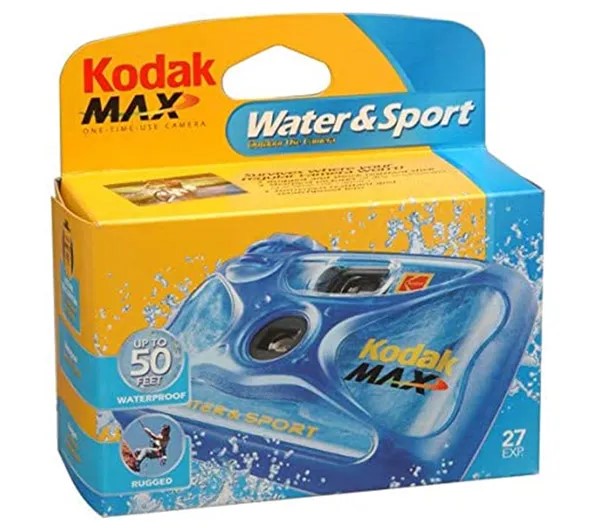
The Kodak Weekend Water & Sport disposable camera is a great choice if you are looking for a waterproof camera that will last a lifetime. The exterior of the camera is waterproof and can be used in snowy or misty conditions.
The Kodak Waterproof & Sport has 27 exposures, but the Kodak Max 800 film gives the camera more versatility underwater and in low-light conditions. This disposable camera does not have an integrated flash, unlike its non-waterproof counterpart. Despite the fact that 800 ISO film is included, you won’t usually need it.
- Waterproof up to 15 meters (50 feet)* Superior quality and image clarity
- Durable
- Anti-scratch
- Images can sometimes be blurry
4. Fujifilm Quicksnap Waterproof Camera
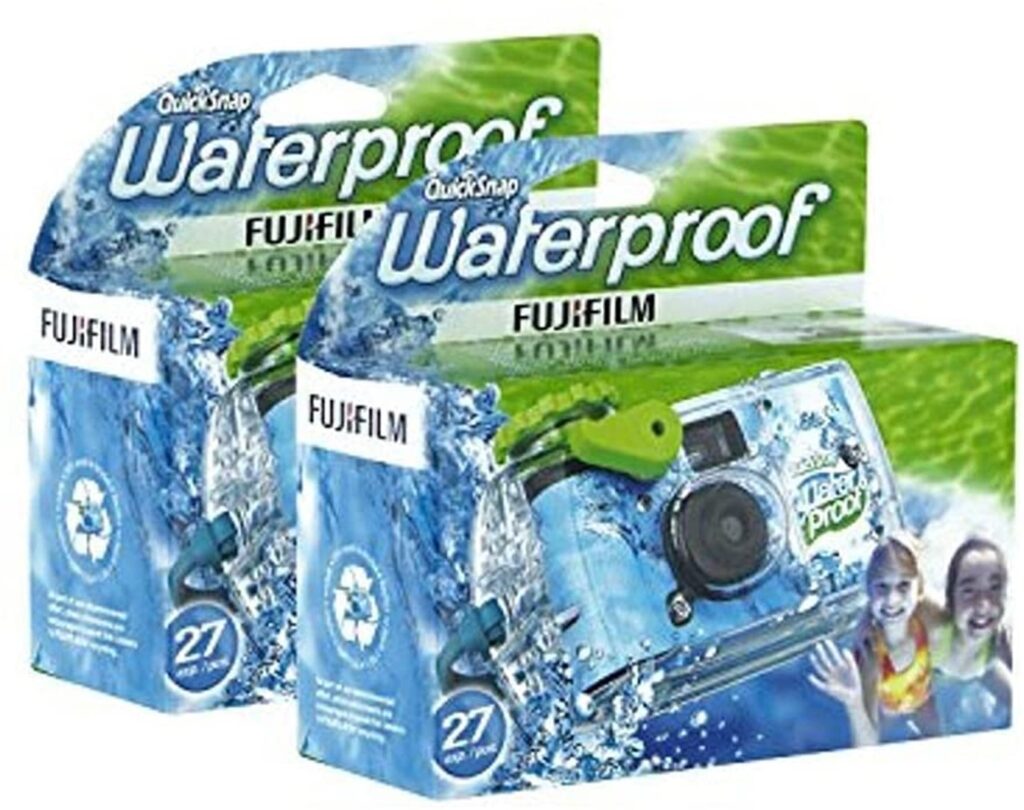
The Fujifilm Quicksnap Waterproof Camera is undoubtedly the best disposable waterproof camera available. It includes 27 frames of Fujicolour Superia XTRA 800 film. This film is known for its incredible colour renditions and ability to perform well in low-light situations. This is great for if you plan to take it out on the water.
The Quicksnap Waterproof Camera is a great choice if you’re shooting in sandy or dusty conditions like the desert or beach. All those tiny particles won’t be able get inside the camera and ruin your shots.
This handy wrist strap is a great addition to your camera’s security, especially when you are using it in the water. The last thing you want is for your camera to sink to the bottom and become unusable.
- Waterproof up to 5 meters (17 feet)
- Hand strap included
- Durable
- Does not have an auto-wind function
5. ILford HP5

If your photography style is more black and white than colour (or even if you fancy changing it up) then the HP5 will be right up your street. Loaded with a 35mm black and white HP5+ film with a 400 iso you’ll be capturing the world in monochrome with ease.
Luckily, this camera also has an in-built flash with a 3-meter range for those times when the natural light isn’t quite enough. However, the flash button is a little hidden in the bottom left hand side and requires you to slide and hold until the flash is charged.


